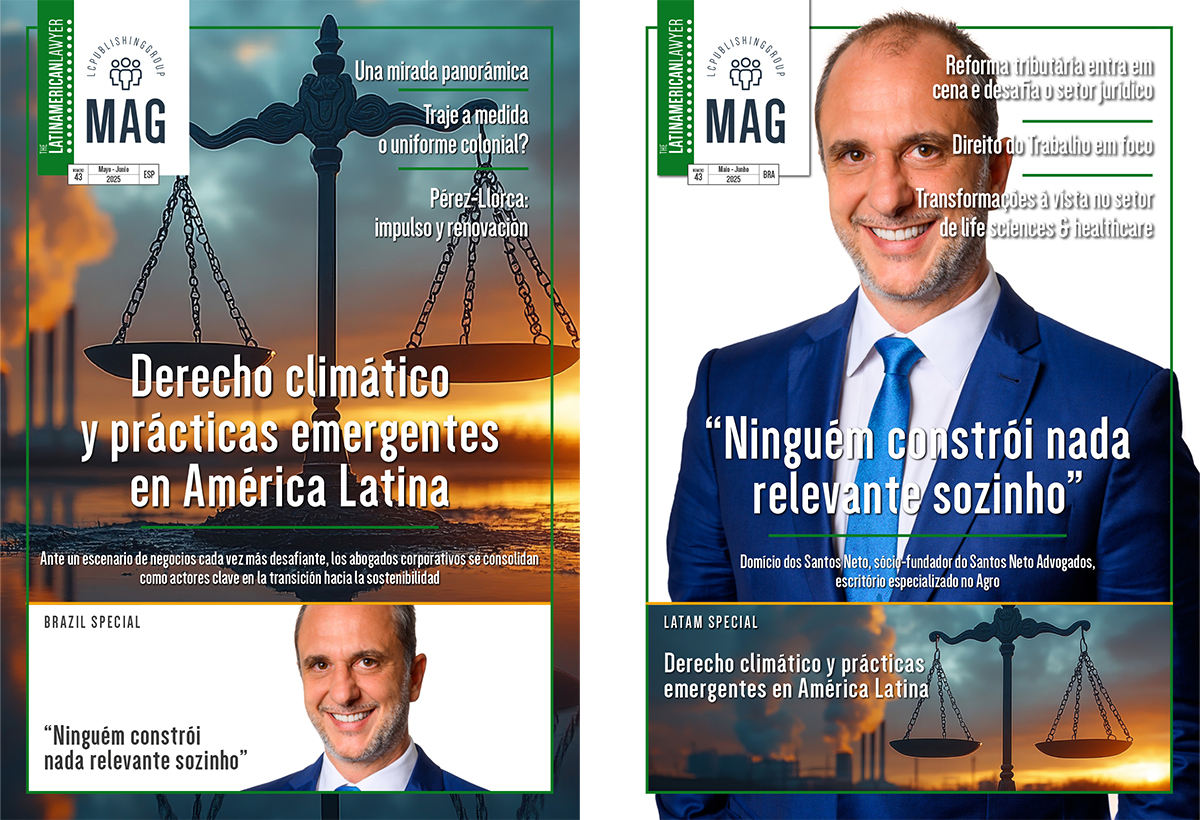Latin America Special Report 2008: dancing to a new tune
In contrast to Europe and North America, Latin America has hardly been affected by the global credit crisis, say lawyers in the region. Many of its economies are even experiencing significant growth, capitalising on the continuing strong international demand for the region’s mineral and agricultural commodities. As a result, they say, many parts of the region are seeing an upturn in transactional activity, and increasing levels of both inbound and outbound investment
Of all the countries across Latin America the one that is now drawing the most attention for its economic performance is Brazil. With GDP growth at 5.4% it is, say many, finally beginning to fulfil its economic potential and is taking centre stage among the so called BRIC (Brazil, Russia, India and China) emerging economies.
The presidency of Luis Inácio Lula da Silva, say lawyers in the country, has taken many by surprise with an agenda of pragmatic policies intended to address both the country’s macroeconomic and social problems.
Just as the economy is being transformed so is Brazilian society, as average income increases and inequality is mitigated. The country has become a magnet for foreign direct investment and the stock market is booming.
Emblematic of the mood sweeping the country was the long-awaited investment grade given by both Standard & Poor and Fitch in April, and say lawyers, May’s merger of the São Paulo Stock Exchange (Bovespa) and the Brazilian Mercantile and Futures Exchange (BM&F) – Bovespa BM&F is now the second largest stock exchange in the Americas and the third largest in the World.
Alexandre Bertoldi, Head of M&A at Pinheiro Neto Advogados in São Paulo notes that market sentiment has clearly changed in Brazil. “Last year was exceptional in all areas, this year the trend was mitigated by external factors that are well known, however, the amount of M&A activity has so far compensated for any decline. The level of sophistication of recent transactions has changed beyond recognition.”
Indeed, M&A in Brazil has experienced an incredible turnaround say lawyers, with Brazilian companies now looking beyond their captive domestic market and expanding not only across Latin America, but also to China, Africa, the US and Europe.
But inbound investment is also significantly up. The country’s construction and real estate sectors are booming, driven by the continuing availability of credit and increasing tourist demand. “Building companies not long ago made their debut in the São Paulo Exchange and are now investing heavily in segments that vary from residential, commercial, depots to rural properties. Economic stability has also driven business to smaller cities, beyond the traditionally dominant Rio de Janeiro – São Paulo axis,” says Rossana Duarte, real estate expert at Tozzini Freire Teixeira e Silva.
 Inward investment is a trend that Antonio Meyer at Machado Meyer Sendacz e Opice Advogados in São Paulo believes will not slow. International investment may now encompass much of the economy, but significant, he says, is the growing emphasis towards the country’s agribusiness, mining, infrastructure and energy sectors.
Inward investment is a trend that Antonio Meyer at Machado Meyer Sendacz e Opice Advogados in São Paulo believes will not slow. International investment may now encompass much of the economy, but significant, he says, is the growing emphasis towards the country’s agribusiness, mining, infrastructure and energy sectors.
“In addition, we will see more activity in the energy sector in connection with both the development of new (biodiesel) and traditional sources (thermo-electric and hydro-electric), but also M&A in industrial and retail sectors as well as infrastructure; and there is also now a rise in tourism in the north and northeast regions of the country.”
Powering change
The energy sector is one that lawyers throughout Latin America identify as holding significant promise. A recent example of the continent’s change of fortunes is the enormous interest now being shown in the biofuels sector, regarded by many as a viable alternative to the global dependence on oil.
Brazil, to a lesser extent Colombia, and a number of Central American and Caribbean countries have however been at the centre of heated discussions regarding the production of Ethanol – alcohol extracted from plant starch or sugar cane – and which has been blamed for the sudden rise in world food prices.

Pedro Seraphim, biofuels specialist at Tozzini Freire Teixeira e Silva Advogados in São Paulo strongly disagrees with such assertions. “The ethanol sector, at least in Brazil, is not at all responsible for the rise in world food prices. The sector, unlike in the US, does not take up land that is used for crops. Indeed, Brazilian food production has been expanding simultaneously with the production of sugarcane ethanol.”
For an economic product that has been part of the regional economy since colonial times, it is surely going through unprecedented change. Brazil’s largest ethanol producer, Cosan, last April announced the $1bn (€640m) acquisition of ExxonMobil’s entire Brazilian fuel distribution business (including 1,500 outlets). The deal, say lawyers, makes it the first company in the world to dominate the whole biofuel-making process, from production to distribution.

But noteworthy also, says Seraphim at Tozzini Freire, is the increasing emphasis being placed on the sector by the major global energy companies. Energy giant BP (British Petroleum), for example, last April acquired a £1bn 50% stake in Tropical BioEnergía, which is investing in ethanol refineries in central Brazil. It is the largest international investment made in the country’s bio-ethanol industry, he says.
Also notable, is the Goldman Sachs’ backed venture: São Paulo-based Brazilian Energy Renewables Co, which has plans for ten ethanol plants and a new biofuel pipeline to Santos, Brazil’s largest port, by 2015.
But investments are also being made in hydroelectric, solar and wind energy developments. Portugal’s EDP Renováveis in July entered the Brazilian renewables market with the acquisition of shares in Central Nacional de Energia Eólica (Cenaeel), alongside EDP Energias do Brasil. Significant also are the investments being made in oil and gas exploration. Iberia’s Repsol and Galp are among the companies hoping to benefit in new oil discoveries off the coast of Brazil. In July, Repsol announced a $1.5bn (€960m) investment to drill for new oil deposits in the Santos Basin discovered last year.
Shared optimism?
It is not however just Brazil that is benefiting from increased economic optimism and growth. The next biggest economic engine in the region is clearly Mexico, say lawyers. The country is benefiting from its proximity to, and significant trade with the US, but it is also seeing substantial investment from Canada and Spain.
“Although the Mexican economy is susceptible to US economy cycles, the Mexican financial system has successfully managed to soften and delay any impact resulting from a decline in US activity,” says César Cruz Ayala at Santamarina y Steta in Mexico City.
The country is nonetheless seeing increasing activity in real estate development, tourism, construction and infrastructure, auto industry, aeronautics and financial services, he notes. An area of potential further growth is the country’s financial markets, which remain dominated by a relatively small number of global players.
“The relatively low penetration of the banking sector among large parts of the population, particularly in high-growth segments such as mortgages and consumer lending, makes us believe that start-ups and M&A activity within the industry may improve significantly in the years to follow,” says Cruz Ayala.
In addition, an increasing number of foreign companies are looking to capitalise on the country’s bouyant capital markets. Spanish energy group Iberdrola made a landmark Mexican bond offering in July, the first-ever by a foreign issuer, and which raised $145m.
The situation in Mexico contrasts however with that found at the opposite end of the continent, in Argentina, where optimism is much more measured.
Mass protests against the incumbent government of President Cristina Kirchner by the rural sector, as a result of proposed tax increases on agricultural exports – in high demand globally – have done little to raise confidence.
The country has already this year seen the high profile departure of international investors, nationalisations (notably of Aerolineas Argentina following its sale by Spanish group Marsans), and the sell-off of assets by international groups (Repsol recently sold a stake in its regional subsidiary Repsol YPF to Argentinean industrial group Peteresen).
According to Thomson Financial, in 2007 Argentina saw 160 M&A deals, with a total value of $9.1 billion, while the first six months of 2008 saw only 45 deals, with a combined value of $413m (€265m).
“Argentina seems trapped in its old political dilemma, whether it should follow right or left, and because investors have a choice as to where to invest, they much rather favour Chile and Brazil,” says Ricardo Beller at Marval O’Farrell & Maizal in Buenos Aires.
Confidence may be low but it is not however all bad news. Camargo Correa, the Brazilian owner of Loma Negra, Argentina’s largest cement producer has announced a $200m (€128m) investment in a new plant near the Chilean border, and the perception is that while the country’s short-term prospects may be poor, there is much greater confidence in the medium to long-term potential.
“The country can be expected to resume its normal path after the current crisis brought about by the rise in export duties – which was rejected by congress on July – is settled,” says Diego Serrano Redonnet at Pérez Alati Grondona Benites Arntsen & Martínez de Hoz.
Also positive about future prospects is New York Firm Curtis Mallet-Provost Colt & Mosle, which has now announced a strategic alliance with local firm Fernandez Quiroga Ayarragaray & Ocampo.
Across the Andes and in Central America
Chile, more familiar for headlines of success, is also slowing economically. Growth was only around 3% for the first half of the year, the lowest rate since 2002. And rising inflation is directly connected to the country’s dependency on oil and energy imports, say lawyers.
Nonetheless the legal community remains optimistic. Jorge Carey, Chairman of Carey & Co
Brazil’s new dancing partners
Unsurprisingly, Brazilian optimism has attracted the attention of a number of major international law firms aspiring to operate alongside the established dominant Brazilian and other regional law firms. Clifford Chance, Linklaters, White & Case and Shearman & Sterling are already established in São Paulo, where Simpson Thacher & Bartlett also recently announced plans to open to support its growing local and regional Latin America practice.
Alexandre Bertoldi at Pinheiro Neto is among those who find such development very positive. “It can only bring benefits for it allows the local lawyers and firms to achieve great synergy. It also goes to show the appeal of the jurisdiction.” Mike Kachel at Clifford Chance agrees. “All of the work being done in our São Paulo office is cross-border. On the securities side we have a good blend of issuer-side work, where our local presence is particularly useful.”
Portuguese law firms also have extensive market knowledge in the area and in most cases have been operating, albeit through associated offices, for decades in the region. In Brazil a number have established very close referral links.
Among them, Morais Leitão with Mattos Filho Veiga Filho Marrey Jr e Quiroga, Vieira de Almeida with Pinheiro Neto, and PLMJ with Tozzini Freire Advogados. Likewise, the leading Spanish firms are also well-represented: Uría Menéndez has ties with Dias Carneiro Advogados, Cuatrecasas with Machado Meyer Sendacz e Opice, and Gómez-Acebo & Pombo is aligned to Pinheiro Neto.
Garrigues is among those looking to build closer ties across the region, where the firm’s Affinitas alliance now includes firms in eight countries. “Latin America continues being the natural field where Spanish companies are in continuous expansion. Countries like Brazil, Colombia, Chile and Mexico are in growing economic cycles, where Spanish multinationals are playing a very active role,” says Albert Collado, Head of the firms, International Committee.
The major development however, suggests Diego Vargas, head of the Madrid office of Maniega & Soler, is that while previously it was Brazilian firms approaching Iberian firms the reverse is now true. “The romance between Iberian and Brazilian firms is real and fashionable. Now the firms that used to be seduced have themselves to seduce, Brazil is the girl that everyone wants to dance with.”
comments, “Chile is the world’s largest copper producer and, as such, continues to attract great interest of mining companies including PHP, Anglo American, Codelco, Pelambre and others.”
Also significant says José Maria Eyzaguirre, partner at Claro & Cia, is the growing importance of infrastructure projects. “Noteworthy, though not M&A, is the fact that project finance in energy transactions has increased dramatically as a consequence of the curtailment of natural gas supply from Argentina. This has created pressure for the construction of all types of energy projects, ranging from the conventional (hydro and coal) to renewables (ie eolic)”.
In Central America too the sentiment is upbeat. Political stability across the region is leading to an upturn in economic confidence. In addition the ratification of the Central American Free Trade Agreement (CAFTA) is also now prompting regional business consolidation.
Costa Rica continues to benefit from its position as a regional hub for foreign multinationals, but it is also reaping the benefits of a long established environmental conservation campaign, say lawyers.
“Costa Rica has about 30% of its landscape dedicated to conservation. The country has experienced a real estate boom and the increase in eco-tourism has become a real force in the economy. Therefore, the protection and use of biodiversity in the country is very high profile,” say Jose Antonio Muñoz and Pedro Muñoz at Arias & Muñoz.
CAFTA has also had a significant impact on elements of the regional economy, says Mauricio Salas at BLP Abogados. “CAFTA incentives now allow for an interesting niche in ethanol processing / export from Central America. But we have also noted an increased attention in other renewables, such as biodiesel, wind and small hydro generation projects.”
Costa Rica is therefore enjoying the outcomes of an increase in both exports and investment, says Alejandro Batalla at Batalla & Asociados. Business related to construction, agriculture, manufacturing and communications have grown significantly. This translated to a national growth rate of 8.2% in 2006, the highest in eight years.”
The view from the top
There are inevitably variances in the economic performance of Latin America’s economies, and it remains a patchwork of relative success and failure.

The populist path of the governments, notably of Bolivia, Venezuela and Ecuador, suggest some is now resulting in rising inflation, falling international investment and in places, civil unrest.
Nonetheless, the view from the World Bank Vice President for Latin America, Pamela Cox, remains upbeat and that the region is increasingly self-reliant. “The maxim that if the US sneezes, Latin America catches pneumonia, is history,” she says. “The region has revealed an impressive capacity to withstand the challenges of the financial crisis and the slowdown of the largest world economy, which holds no parallel in the recent past”.
Lawyers, and economists, agree that the region continues to face challenges: limited healthcare and educational opportunities, low productivity and poor infrastructure. There is wide agreement that the reformist agenda should be directed at combating social inequalities and to strengthen institutional framework, including security and justice, but also to reduce bureaucratic red tape and to promote innovation
The continent is trying to steer a delicate path between sustainable growth and controlled inflation, say lawyers, to help maintain economic stability and to encourage inward investment. By correctly addressing these issues Latin America should ensure that it will not have another generation of lost opportunities.















